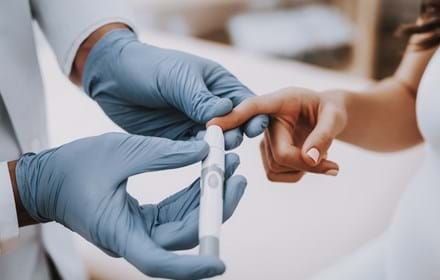
Spray to improve healing for people with diabetes-related wounds
A new product is available to help slow-healing wounds that can be a complication of diabetes.
Granulox is a haemoglobin spray made by infirst Healthcare, and is the first of its kind to improve the levels of oxygen in chronic wounds, which is widely recognised as important for healing wounds such as foot ulcers, leg ulcers, pressure sores and post-surgical wounds.
The spray is proven to significantly speed up healing time for slow-healing venous leg ulcers with results recently presented at the Wounds UK Annual Conference demonstrating a high treatment response rate even in patients who have failed standard care.
Case studies showed that helping an increase in oxygen concentration at the surface of a chronic wound using Granulox could significantly reduce pain and restart wound healing in hypoxic wounds (wounds that are not getting oxygen).
Evaluations were carried out in people with chronic wounds suffering from conditions including diabetes, systemic sclerosis, spina bifida and rheumatoid arthritis. Those who had failed to achieve complete wound closure, despite several adjustments to their care regimens prior to Granulox, saw significant improvement following treatment with the spray and complete wound closure was achieved in the majority of patients.
Manfred Scheske, CEO of infirst Healthcare, said: “Recognising patient needs and addressing these effectively is an important part of our work; there are too many people suffering from chronic wounds. More and more data through real case scenarios is allowing us to show how Granulox can really make a difference in wound healing. We are delighted to be launching Granulox at the Wounds UK Annual Conference. Its unique delivery mechanism and proven efficacy make this a pivotal product in chronic wound care treatment.”
Granulox was launched in the EU in 2012 and will be available to the NHS in England and Wales and to NHS Scotland from November 2014, subject to local formulary inclusions for wider adoption. A number of pilot usage studies are already under way in leading UK Trusts, CCGs and Healthboards.
Emma Howard, Community Diabetes Lead Podiatrist at Oxford Health NHS Foundation Trust and member of the DRWF Editorial Advisory Board, said: “Every new development in wound care gives hope to those with non-healing foot wounds. There are many reasons that foot ulcerations do not heal including, infection, pressure and underlying vascular status. The management of foot ulceration is different in nature to the leg wounds mentioned in the presentation. Dressings/topical wound agents are only one part of the holistic treatment of foot ulceration and no one dressing is suitable for every foot wound.”
It is estimated that 7,000 people with diabetes will require amputations in 2014/15, mainly because of non-healing diabetic foot ulcers due to hypoxia.
Case study from Salford Royal Hospital NHS Foundation Trust
Joe Smith*, 46, from the Salford area was diagnosed with type 2 diabetes 13 years ago and had one toe amputated in May 2013 following complications of foot ulceration. The post-amputation wound failed to heal despite different preparations, including foams and hydrogels, being used over a nine month period. When Mr Smith started treatment with Granulox, the wound size was 14x9mm. After three months using the spray, the wound had closed completely. It had been persistent for a total of 12 months and static for two months, prior to treatment with the spray.
*Real name withheld to protect identity
Support DRWF by making a donation here
Find out more about DRWF-funded research here
Find out more about DRWF fundraising here
For latest update follow DRWF on Facebook, Instagram and Twitter
To receive the charity’s latest bulletins as they become available, please sign up here
Read DRWF diabetes information leaflets here
Join the Diabetes Wellness Network here
I would like to make a regular donation of
I would like to make a single donation of
There are lots of ways to raise money to support
people living with all forms of diabetes.
Bake, Swim, Cycle, Fly ... Do It For DRWF!
Fundraise with us
Recent News


